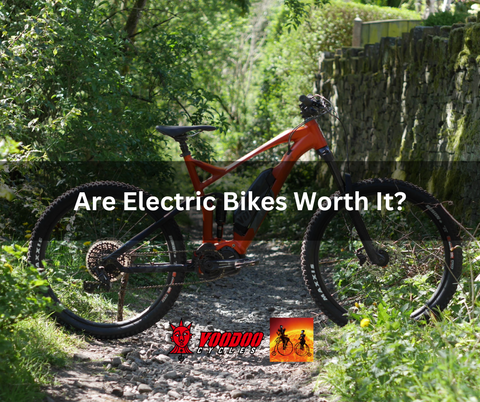
Are you thinking about getting an electric bike (e-bike)? It’s a big decision! E-bikes are becoming more popular in 2025, but you might be asking, "Are they really worth it?" While e-bikes can cost more upfront, they can save you money on fuel costs and public transport. Plus, they help improve your health through active travel. In this article, we’ll break down the costs, benefits, and how an e-bike can fit into your lifestyle. Whether you’re a professional athlete, commuter in the city, looking for a fun ride, or trying to reduce your carbon footprint, e-bikes could be the perfect solution for you. Let’s dive in and find out if an e-bike is a smart choice for 2025!
How to Choose an E-Bike Within Your Budget in 2025
a. Establishing Your E-Bike Budget
E-bike prices vary widely to suit different needs and budgets:
-
Entry-level (Under $1,500): Ideal for commuting, these budget-friendly e-bikes offer basic features and standard battery life. Brands like Co-op Cycles provide solid starter options.
-
Mid-range ($1,500–$3,000): A balance of performance and affordability, featuring better motors (e.g., Shimano) and improved battery life. Voodoo Cycles Limba E-Bike and Mambo E-Bike fit this category, offering comfort and reliability for urban and recreational riders.
-
High-end ($3,000+): Premium models with smart displays, connectivity, and high-performance motors (e.g., Bosch). Voodoo Cycles Bizango E-Bike and Canzo E-Bike deliver top-tier performance for serious riders and off-road adventures.
b. Factors Influencing E-Bike Prices

Image Source: Voodoo Cycles Bizango E-Bike 2025
Several key factors contribute to the overall price of an e-bike:
-
Motor and Battery: The motor efficiency and battery life significantly impact the price. Motors from Bosch and Bafang are known for their reliability and performance, while advanced battery technology, such as that found in Shimano EP8 systems, can extend your range and reduce range anxiety.
-
Components: High-quality components like Tektro brakes, Schwalbe tires, and Shimano gears contribute to the e-bike's durability and reliability, increasing the purchase cost. These components enhance e-bike safety and performance, ensuring a smoother and more enjoyable ride.
-
Features: Smart displays providing real-time data, connectivity features, and customization options can drive up the price. If you prioritize essential functionality over advanced features, a basic model may suffice.
Type of E-Bike: The intended use of the e-bike also affects the price. Mountain bikes with air suspension and mid-mounted motors typically cost more than city bikes designed for urban mobility. Similarly, cargo e-bikes, designed for carrying heavy loads, often come with a higher price tag due to their reinforced frames and powerful motors.
c. Used or Refurbished Options
For budget-conscious buyers, used or refurbished e-bikes offer significant savings while providing quality components. Just check for wear, battery health, and warranty details.
By considering these factors, you can find an e-bike that fits your budget and riding needs—whether for commuting or off-road adventures.
Long-Term Savings and Benefits of Owning an E-Bike in 2025
 Image Source: State Bicycle
Image Source: State Bicycle
Quantifying Your Transportation Savings
To accurately assess the potential financial savings of switching to an e-bike, it's essential to calculate your current monthly transportation expenses. This includes fuel costs, public transport fares, and car maintenance costs. By quantifying these expenses, you can better understand the investment value of e-bikes and their potential for long-term savings in 2025.
For example, let's say your monthly transportation costs break down as follows:
-
Fuel Costs: $200
-
Public Transport: $100
-
Car Maintenance: $150
This totals $450 per month. An e-bike, with minimal charging costs (approximately $5-10 per month) and reduced maintenance, can drastically cut these expenses. Even factoring in occasional battery replacement, the long-term savings can be substantial.
Government Incentives and Financial Support
Being aware of government incentives, tax breaks, or subsidies can significantly reduce the electric bike prices and enhance the investment value of e-bikes. These financial supports aim to encourage e-bike adoption, promoting green transportation and emissions reduction.
Examples of such incentives include:
-
Tax Breaks
-
Subsidies
-
Voucher programs
These initiatives can significantly offset the initial purchase cost, making e-bikes more accessible to a wider range of consumers.
By carefully considering these long-term savings and benefits, you can appreciate the full potential of electric bikes as a smart and sustainable transportation solution. Embracing green technology not only benefits your wallet but also contributes to a healthier planet and a more active lifestyle.
Environmental Impact: Reducing Your Carbon Footprint
Identifying your primary concerns about the environmental impact of your current mode of transportation is crucial for evaluating the potential benefits of switching to an e-bike. In 2025, emissions reduction, congestion relief, and green transportation are key factors driving the adoption of electric bikes as a sustainable solution.
Key environmental concerns often include:
-
High carbon footprint from fuel consumption
-
Air pollution
-
Traffic congestion
-
Resource depletion
E-bikes offer a tangible solution to these concerns. By reducing your reliance on fossil fuels, you're directly contributing to environmental sustainability and reducing your carbon footprint. E-bikes also produce zero emissions during operation, significantly improving air quality in urban environments.
Prioritizing Health and Fitness: Active Travel Made Easy
The importance you place on health and fitness benefits significantly influences your e-bike selection. In 2025, e-bikes offer active travel and enhance fitness benefits, making sustainable transportation an integral part of your active lifestyle.
E-bikes provide an opportunity for active travel, improving cardiovascular health, building and strengthening muscles, and enhancing overall mental well-being. Pedal assist allows you to adjust the intensity of your workout, making it accessible to a wider range of fitness levels.
Addressing Common Concerns and Misconceptions About E-Bikes
Let's address some of these common misconceptions head-on to provide a clearer understanding of what owning and riding an e-bike truly entails in 2025.
How Long Does an E-Bike Battery Last and How Can You Maximize Its Life?

Range anxiety—fear of running out of battery—concerns many e-bike riders. Understanding battery life factors and optimization can help ease this worry.
-
Battery Capacity and Technology: Battery type and capacity impact e-bike range. Lithium-ion batteries (300Wh–700Wh+) offer longer rides with higher capacity.
-
Riding Conditions: Terrain, rider weight, and assist level all impact battery consumption. Uphill riding and higher assist levels drain the battery faster.
-
Smart Power Management: Many e-bikes, including models from Voodoo Cycles, are equipped with smart power management systems to optimize battery usage. Advanced battery technology ensures efficient performance. The Shimano EP6 motor, for example, enhances battery management, improving overall range.
-
Maximizing Battery Life: To extend your range, consider:
-
Using lower assist levels when possible.
-
Maintaining optimal tire pressure.
-
Avoiding excessive weight.
-
Planning your routes to minimize steep inclines.
-
-
Battery Replacement Costs: E-bike batteries can last for years with proper care, but replacements cost $300–$800+, depending on capacity and brand.
Who Should Consider an E-Bike in 2025?
Breaking the Misconception of E-Bike
E-bikes aren’t just for those who struggle with traditional cycling—they’re for everyone! Whether you're commuting, exploring trails, or just enjoying the ride, e-bikes cater to all fitness levels and lifestyles.
Why Choose an E-Bike?
-
Enhanced Mobility – Pedal assist makes longer rides easier, perfect for any age or fitness level.
-
Versatile Options – From city cruisers to mountain bikes
-
Fitness-Friendly – Get an active workout while adjusting assistance to match your effort level.
- Eco-Conscious Choice – Reduce your carbon footprint and embrace green transportation.
E-bikes aren’t just an alternative—they’re a smarter, more accessible way to ride!
"E-bikes Are The Same as Electric Motorcycles?"

E-Bikes vs Motorcycles: Understanding the Differences
E-bikes and electric motorcycles both leverage electric motors, yet cater to distinct needs and regulations, making them different modes of sustainable transportation. Understanding these differences is vital for consumers considering eco-friendly travel and urban mobility in 2025.
| Feature | E-Bikes | Electric Motorcycles |
|---|---|---|
| Pedal Assist | Includes pedal assist systems enhancing fitness benefits and making active travel more accessible. Riders pedal while receiving assistance from the motor, contributing to health benefits. | Typically do not have functional pedals. |
| Motor Power and Speed | Limited motor power (usually 250-750 watts) and restricted top speeds (often 20-28 mph). | More powerful motors, achieving much higher speeds, similar to traditional motorcycles. |
| Regulatory | Often classified as bicycles, allowing usage of cycling infrastructure, such as bike lanes and trails. Contributes to congestion relief, especially in urban commuting. | Generally classified as motorcycles, requiring licensing, registration, and adherence to motor vehicle regulations. |
| Design and Usage | Resemble traditional bicycles, focusing on cycling comfort innovations and versatility for urban commuting, daily commutes, and off-road adventures. Promote cost-effective options. | Similar design to standard motorcycles, emphasizing speed, power, and longer-distance travel. |
Conclusion: Making the Decision - Is an E-Bike Right for You?
After a comprehensive cost-benefit analysis, embracing electric bikes represents more than just a transportation upgrade; it's a step towards a lifestyle that blends active travel with efficient urban commuting. The potential for integrating fitness benefits into your daily routine, coupled with reducing your carbon footprint, makes e-bikes a compelling option. However, it's important to acknowledge remaining hesitations, such as range anxiety and battery performance, which can be addressed by seeking transparent data and customer feedback on advanced battery technology from brands like Bosch or Shimano EP8.
Ultimately, the decision hinges on aligning your specific needs with the available e-bike types. City bikes, known for their comfort innovations and suitability for daily commutes, represent a versatile choice for enhancing urban mobility. To make a fully informed decision, leverage a multi-faceted approach by delving into online e-bike reviews, consulting with friends and family, and visiting local bike shops for test rides. Evaluate factors like performance metrics, reliability, and customer support, and remember that embracing green transportation is an investment that extends beyond your wallet, contributing to a healthier planet and a more active, sustainable lifestyle.






